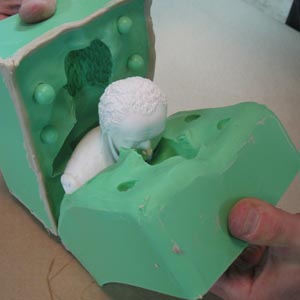You have no items in your shopping cart.
How to Cast Latex Moulds
 For larger items a casing or mother mould is required to provide support and minimise distortion of the latex mould. This also serves to protect the surface of the latex film against ozone attack that causes cracking and weakens the rubber film.
For larger items a casing or mother mould is required to provide support and minimise distortion of the latex mould. This also serves to protect the surface of the latex film against ozone attack that causes cracking and weakens the rubber film.
Before casting, it is useful to apply a mould release such as ‘Remove It 20 VOC’ to the latex mould surface. Do not use grease, petroleum oils or stearic acid solutions as release agents.
‘Remove It 20 VOC’ mould release is a water miscible product that can be used to release plaster or concrete from latex rubber. It can also be used between the latex mould and the mother mould or as a lubricant when slipping a thin mould over itself to remove the casting. Alternatively a solution of caster oil in alcohol in a ratio of 1:2 works well as a release agent with concrete items. Both types of release agents can be applied by brush or spray. For plaster castings a solution of dishwashing detergent in water, approximately 50ml in 10 litres helps to stop the plaster from sticking and keeps the mould clean and pliable. This solution should be applied to the mould and then allowed to dry completely before pouring plaster.
Prepare casting medium as per the supplier’s instructions and pour into the latex mould ensuring no air bubbles are trapped in the liquid. When the material has set, carefully remove the casing (if used) and then the latex mould. The mould should be cleaned and release agent applied before the next casting.
Precautions
• During hot weather, do not be tempted to apply thicker layers of brush latex. It is much better to apply a thinner film which will dry much faster allowing more coats to be applied. A thicker coating can seal on the surface, trapping moisture underneath and result in poor drying through the film. This can result in cracking and poor tensile strength.
• In common with all natural based products, contamination with even extremely low concentrations of copper, manganese, brass and zinc will cause rapid aging and deterioration of the rubber. In storage and processing avoid all contact with these metals from application equipment, water supplies and fake ‘gold’ paint.
• When casting concrete products into latex moulds some grades of cement generate a pink/purple staining on the surface of the finished article. This effect is usually reversible on exposure to natural light and in no way affects the structure of the finished product.


